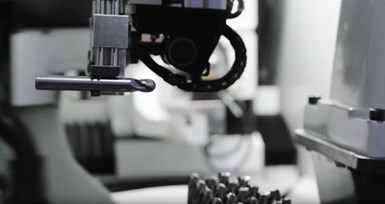Preparing Tool Grinding Machines for IoT
Internet of Things (IoT) doesn’t require scrapping existing tool grinding machines, but investing in new technology, such as communication networks and automation, is necessary.

Adapting CNC tool grinding machines for a smart factory environment involves some investment and a new mindset.
One concern that manufacturers have about moving toward a smart factory is whether or not it means scrapping existing CNC machines, including grinding machines, and investing in a whole new set of machinery. This isn’t the case. However, it does mean that manufacturers will have to upgrade some technology and change the way they think about how they operate.
A New Way to Think About Tool Manufacturing
In the future, manufacturers won’t have to be as hands on with what they produce anymore. Instead of a manual production line, they will have an integrated network of machines that is more efficient in manufacturing processes, intellectual property generation, tool design, customer responsiveness, cycle time, profitability—the list goes on. Across the business, automated machines will take care of more of the laborious tasks before work begins.
Manufacturers can’t let the enormity of what they can achieve with a smart factory cause them to stick to what they have always done because it’s easier. With a bit of investment to upgrade existing technology and facilities, they can reap the benefits of automation.
Working with a smarter CNC grinding machine will require some investment and some understanding of how the new infrastructure will work. The benefit is that instead of manufacturing products with manual intervention, manufacturing teams can program machines ahead of time so they can do what needs to be done throughout the day. And not only can CNC machines manage production, they can also collect and analyze data to make automatic adjustments to production in real time.
Connecting a CNC Grinding Machine to a Smart Factory
While manufacturers will be able to make use of existing CNC machines, it will require them to embrace some new technologies. To work effectively with other machines and maximize the benefits of a smart factory, each CNC grinding machine will need to be connected to a communication network. Having a machine connected to a network may seem daunting, but the benefits are unparalleled. The CNC machine becomes part of a smart, connected set of tools working together to make your work easier.
Depending on the age of the machine, it can be connected using either Wi-Fi (the best option-to avoid messy cabling) or a cabled LAN connection. While newer machines come Wi-Fi enabled, older machines can be retrofitted with a Wi-Fi adapter and software drivers. Check with the vendor first to make sure the driver software is supported.
Exploit a Niche, Finesse Offerings and Charge Accordingly
Small companies are able to offer personalized services that bigger business can’t. They understand their customers’ needs. They sell the precise product customers need to keep their operation running. Customers need manufacturers as much as manufacturers need customers.
Being small can be a great selling point. Small businesses can adapt to the

CNC machines, including Anca’s, come with software that allows flexibility in everything from configuring setup to product gauging and automatic compensations, freeing teams to work on more valuable tasks.
market as it changes and respond to demand. Where potential customers may be frustrated by businesses with long lead times, small businesses have the ability to turn things around quickly and with more flexibility. Smaller companies can also easily expand their offerings for customers who want something they don’t yet manufacture. With the tools and flexibility to make it happen, these companies can show their customers how well they understand their niche.
This kind of specialization is hugely valuable to a business. Small companies not only provide labor and materials, but access to years of knowledge and refinement. It’s been shown that customers will pay more for specialized products that offer this level of added value.
Embrace Automation
Most CNC machines, including Anca’s, already come equipped with comprehensive, advanced software that allows flexibility in everything from configuring setup to adaptive processes like product gauging and automatic compensations, freeing teams to work on more valuable tasks.
By creating automated systems and processes, users immediately have access to more information than ever before – and this is a huge benefit for manufacturers and their customers. Machines can alert users when they’re running low on materials. They will predict maintenance that’s required to keep them operating, avoiding lengthy and expensive disruptions.
Better still, they can become part of a wider network of machines. Integrating with other factories will reinvent the supply chain process. Suddenly, a factory can integrate with its customers and the machines can speak to one another. For example, if a customer is running out of a product a machine shop manufactures, the machines in the shop will get an alert and start the production process without and human intervention.
Move Forward One Step at a Time
Manufacturers don’t need to do all of this at once. There are easy ways to add automation functionality:
- Add after-market software or hardware accessories, such as lasers to measure tools in production, ensuring they meet required design and tolerances.
- Retrofit with automation. Robotic loaders mean lower costs and greater volumes. Robotic loaders can be installed onto a machine at a reasonable price and help users achieve the benefit of lights-out of unattended machine production.
- Enable machine connectivity on older machines through Wi-Fi adapters and software drivers to connect machines to each other and the wider factory.
- Store tool files centrally with tools and wheel servers. Maintaining a database of each tool file that a machine can use for setup is a great place to start with software. Factories can store a range of files centrally, so each machine can access what it needs to get the process going.
Planning Ahead for Future success
This might be new to some factories, but there are tricks they can learn. For example, when moving jobs between machines, each machine needs the same version of the software. Again, this is an investment, but the efficiencies will outweigh the costs in a few months. Manufacturers need to know the requirements like these to make their factories smart.
Those who don’t have a background in scaled manufacturing might need more information before they scope out a strategy. Anca can help customers understand specific requirements and how to incorporate them into the supply chain.
No matter the approach, manufacturers will need to invest in some degree of technology to keep their machines up to date and their operations functioning effectively. Without this investment, other companies will move ahead, as they can produce more complex tools more efficiently. There are many ways to bring CNC grinding machines up to speed for a smart factory. The most important thing is to start.
To learn more, download Anca’s guide on how to build a Factory of the Future.
Anca | 248-926-4466 | machines.anca.com
Related Content
Grindstar Replaces Turning With Efficient Grinding
PMTS 2023: The Grindstar machine uses a method that enables the entire workpiece contour to be ground in a single processing operation.
Read MoreShould You Bring Tool Regrinding In-House?
In some situations, the potentially high investment in an in-house tool grinding process can be justified with a relatively fast ROI. (Includes video.)
Read MoreGrinding Options for Dental Burrs and Rotary Instruments
Equipment to grind dental burrs continues to evolve. Here are five options for grinding these types of workpieces.
Read MoreTooth Flank Grinding Technology Minimizes EV Drive Noise
Drives for electric vehicles require gear components with tight tolerances and excellent surface finishes. Even minimal ripples in the surface of tooth flanks on shafts and gears can cause interference noise in drive performance.
Read MoreRead Next
Industry 4.0 Through Metrology's Eyes
High precision 3D laser and CT scanning bring all the “big data” directly from shop floor to top floor.
Read MorePreparing Precision Turning for Industry 4.0
Ready or not, Industry 4.0 is moving forward, and it’s critical for manufacturers to be ready for it. Many machine tool builders and accessory builders are equipping their products with Industry 4.0 compatibility in anticipation of its implementation by customer shops.
Read More









.jpg;maxWidth=300;quality=90)










